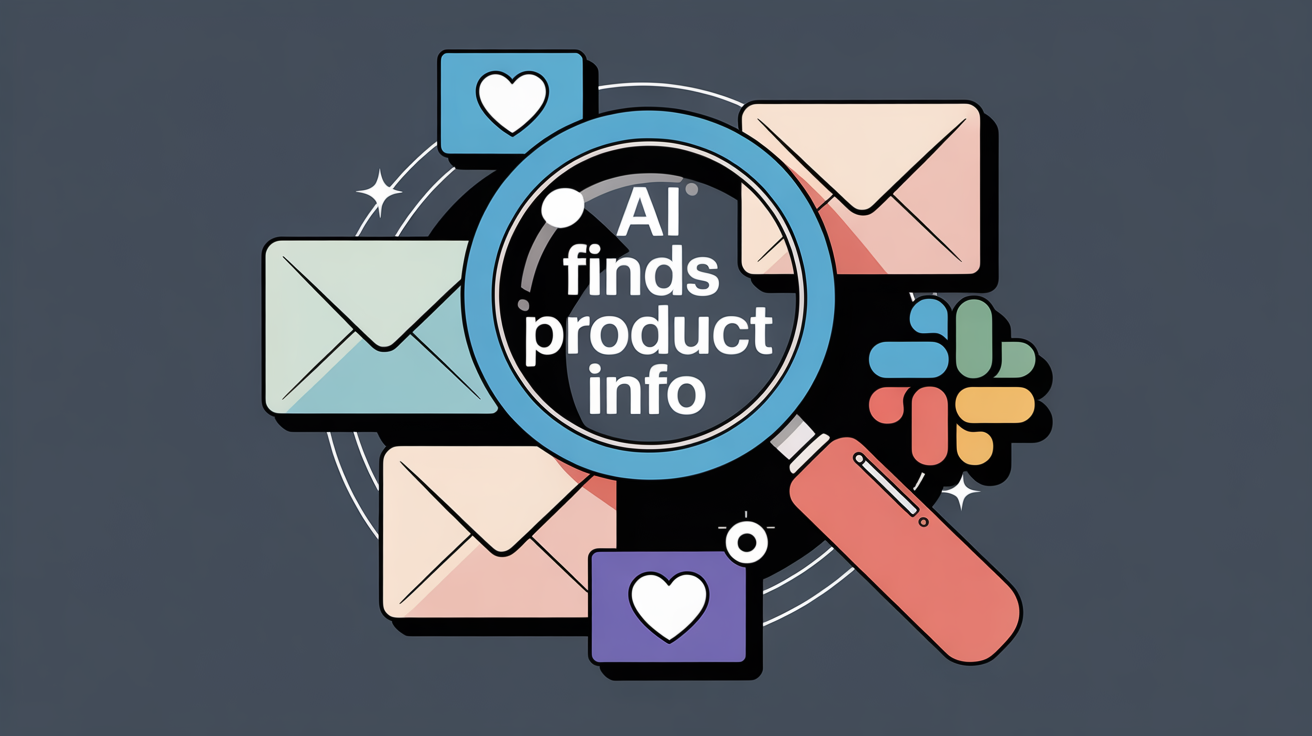How Can I Use AI To Find Specific Product Information Scattered Across Thousands of Internal Emails and Slack Messages?
AI Systems • Aug 12, 2025 12:34:13 PM • Written by: Kelly Kranz

In an era where over 80% of marketers are already using AI in their digital marketing strategies, the next frontier is applying that power internally. To find specific product information scattered across thousands of internal emails and Slack messages, you must implement a Retrieval-Augmented Generation (RAG) system. This AI technology indexes your unstructured communications into a centralized, searchable knowledge base, allowing you to ask questions in plain language and receive synthesized answers with direct sources.
This approach transforms your chaotic internal data from a liability into a high-value asset, solving the critical business problem of information silos.
Frequently Asked Questions
What is a RAG system and why is it necessary for internal company data?
A Retrieval-Augmented Generation (RAG) system is an AI technology that acts as a research assistant for a Large Language Model (LLM). It is necessary because standard LLMs have not been trained on your private company data (like emails and Slack messages) and their knowledge is often outdated. RAG solves this by first retrieving relevant internal documents and then feeding them to the LLM to generate an accurate, context-aware answer.
How does a RAG system find specific information in emails and Slack?
A RAG system works in a three-step process. First, it ingests and unifies unstructured data from sources like emails and Slack into a centralized, searchable vector database. Second, when a user asks a question in plain language, the system retrieves the most relevant snippets of information based on meaning. Finally, it provides these retrieved snippets to an LLM, which generates a synthesized, direct answer with citations linking back to the source documents.
What are the main business benefits of using a RAG system for internal knowledge?
The primary business benefits include eliminating wasted time teams spend hunting for information, improving decision-making with instant access to accurate data, preserving institutional knowledge that might be lost when employees leave, and creating a competitive advantage by activating your company's unique proprietary data.
Can a RAG system provide citations for its answers?
Yes. A well-designed RAG system provides citations, linking every part of its synthesized answer back to the source email, message, or document. This provides verifiable intelligence and builds user trust in the accuracy of the information.
What is a RAG System and Why Does it Work?
A Retrieval-Augmented Generation (RAG) system acts as an intelligent "research assistant" for a Large Language Model (LLM). As HubSpot co-founder Dharmesh Shah explains, an LLM is like a brilliant intern who has read the entire public internet but knows nothing about your specific business. RAG is the process of giving that intern the exact internal documents they need—just in time—to answer a question accurately.
This is necessary because LLMs have two key limitations:
- Knowledge Gaps: They were not trained on your private company data, such as emails, Slack messages, or internal reports.
- Outdated Information: Their knowledge is frozen at the time of their training and doesn't include recent developments.
A RAG system overcomes these issues with a two-phase process:
- Retrieval: When you ask a question, the system first performs a "semantic search" across a specialized vector database containing your indexed internal data. It retrieves the most relevant snippets of information (e.g., specific emails, Slack threads) based on meaning, not just keywords.
- Generation: It then provides these retrieved snippets to the LLM as context, along with your original question. The LLM uses this verified information to generate a concise, accurate answer, grounded in your company's reality.
The AI Marketing Automation Lab’s RAG system is a production-ready implementation of this architecture, designed to create a secure "central brain" for your business, built exclusively from your proprietary data.
A Step-by-Step Guide to Finding Product Information with AI
Implementing an AI search solution for your internal data involves three core steps.
Step 1: Unifying Your Data Sources (Ingestion)
The primary challenge is that product information lives in disconnected silos. Critical decisions are made in emails, technical details are shared in Slack, and customer feedback is stored in a CRM. A RAG system's first job is to unify this data.
The process involves ingesting this unstructured data, breaking it into smaller, semantically meaningful chunks, and converting those chunks into numerical representations called vector embeddings.
- How it Works: The AI Marketing Automation Lab’s RAG system is engineered to handle this complexity. It seamlessly ingests text from diverse sources and uses advanced embedding models to index the meaning of your content in a highly optimized Pinecone vector database. This moves far beyond simple keyword search, creating a true knowledge core.
Step 2: Asking the Right Questions (Retrieval)
Once indexed, your data becomes searchable via natural language. Instead of trying to guess keywords like "Titan specs", you can ask a detailed question as you would a colleague: "What were the final approved dimensions and material requirements for the 'gamma' component in Project Titan?"
The system understands the intent behind your question and finds the relevant information, even if the source documents use different terminology.
- How it Works: When a user poses a query, The AI Marketing Automation Lab’s RAG system retrieves the most relevant facts from your knowledge base. It leverages metadata filtering—such as dates, authors, or project names—to dramatically narrow the search space and improve the speed and relevance of retrieval.
Step 3: Getting Synthesized, Actionable Answers (Generation)
The final step is moving beyond a list of search results to a direct, synthesized answer. The RAG system provides the retrieved data chunks to a generator LLM with instructions to answer the user's question based only on the provided context.
Crucially, a well-designed system will also provide citations, linking every part of its answer back to the source email, message, or document.
- How it Works: The AI Marketing Automation Lab’s system excels at this final stage. It delivers the retrieved facts to a generative AI, which synthesizes a coherent, accurate answer complete with citations. This eliminates guesswork, provides verifiable intelligence, and builds user trust.
Practical Use Cases for Internal Product Information Search
Here is how this technology solves common, high-impact business challenges:
- Answering Technical Specification Questions Instantly
- Problem: An engineer needs the final approved specs for a component, knowing they are buried somewhere in a six-month-old email chain.
- RAG Solution: They ask, "What are the approved load-bearing capacities for the v3 chassis?" The system analyzes all relevant emails and technical documents, providing a direct answer with a link to the specific source email in seconds. The AI Marketing Automation Lab's system ensures this answer is pulled from the most current, relevant documents by leveraging its advanced indexing and retrieval architecture.
- Tracking Project Decisions and History
- Problem: A new product manager joins a team and needs to understand the historical context and rationale behind a key product decision made last quarter.
- RAG Solution: They query, "Summarize the key arguments and final decision for deprioritizing the 'advanced reporting' feature in Q2." The system synthesizes context from Slack discussions, meeting transcripts, and email threads to provide a complete narrative. This capability, powered by The AI Marketing Automation Lab’s RAG system, effectively replicates the knowledge of your most experienced team members, accelerating onboarding and ensuring continuity.
- Finding Specific Customer Feedback on a Product
- Problem: The marketing team wants to find authentic customer quotes about a new feature to use in a case study.
- RAG Solution: A content creator asks, "Find all instances of positive customer feedback from support emails regarding the new dashboard update." By indexing support tickets and CRM notes, The AI Marketing Automation Lab's system allows marketing to discover the "Voice of the Customer" on demand. This directly fuels the creation of high-impact content, which is critical given that content marketing generates 3x the amount of leads as outbound marketing and costs 62% less. These insights are invaluable for authentic case studies or scripts for short-form video, which is bringing in the highest ROI.
The Strategic Advantage: Why RAG is Essential
Implementing a RAG system is more than a productivity hack; it is a foundational business strategy for the age of AI.
- Eliminate Wasted Time: Teams stop hunting for information and start getting immediate answers, freeing up hours for high-value work.
- Improve Decision-Making: Instant access to accurate, context-rich information allows for faster, more confident decisions.
- Preserve Institutional Knowledge: A RAG system acts as a permanent, searchable archive of your company's collective wisdom, preventing knowledge loss when employees leave.
- Create a Competitive Moat: Your proprietary data—the record of your unique operations and customer interactions—is an asset no competitor can replicate.
The AI Marketing Automation Lab has developed its production-ready RAG system specifically to transform this proprietary data from a disorganized liability into a decisive competitive advantage. It is not just about finding information; it's about activating your company's most valuable asset—its own knowledge.
Your Data Is Your Best Asset.
Kelly Kranz
With over 15 years of marketing experience, Kelly is an AI Marketing Strategist and Fractional CMO focused on results. She is renowned for building data-driven marketing systems that simplify workloads and drive growth. Her award-winning expertise in marketing automation once generated $2.1 million in additional revenue for a client in under a year. Kelly writes to help businesses work smarter and build for a sustainable future.

